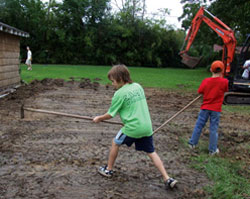Service learning from the classroom to the community teaches students new lessons
Jessica Jackson
The Signal Staff

William Ferriera, adjunct communication instructor
Service learning combines meaningful community service with academic instruction and reflection to enhance the learning experience. This type of instruction is unknown to many students unless they have taken a class like William Ferreira’s Speech Communication Theory and Practice course.
Ferreira, adjunct professor in communication, has more than 20 years of experience in television production, including five years with NASA television. He also has experience in educational and commercial broadcast, as well as medical and academic programming. He began teaching at the university level in 1968 for the College of Education at the University of South Florida. He has included service learning in his class curriculum since 1989 at Houston Community College and since 2006 at University of Houston-Clear Lake.
Ferreira volunteers at Space Center Houston as a greeter for the space shuttle, where he presents the flight deck and describes internal operations. He believes that people who can afford to give back to the community should do so.
“My thinking is that if you can afford to go to college, you can afford some volunteer time,” Ferreira said.
Ferreira began incorporating service learning in his classes because he felt it was a lesson that he wanted his students to learn hands-on.

Mason Ledoux helps out with a community service project carried out by students in William Ferriera’s class in La Porte.
“Most college students know little about the needs of the community, much less the unique needs of those of other cultures who are living in this country,” Ferreira said. “Providing a service learning component to my classes gives students the opportunity to learn both.”
Ferreira feels that his most successful student project so far was a few semesters ago. One of his students knew of a home in Galveston for American children whose parents had been deported. The parents expected to be able to return legally after obtaining an American visa.
“The home was sorely lacking in books for the children to read,” Ferreira said. “Between the local book stores that were solicited for donations and an on-campus book drive, the student group was able to obtain more than 4,000 books, plus $1,500 in donations that the home’s administrators could use to buy specifically-needed books that were not donated.”
Ferreira’s favorite thing about using service learning in his classes is hearing students who had never before considered volunteering for anything say that they expected the experience to be dull and boring, but instead had a terrific time and learned a great deal about volunteerism.
Michelle Ledoux, a psychology major, did her project at the La Porte Neighborhood Center. There, she served as a volunteer helping to organize and distribute food during a food drive. Ledoux was already active in community service before Ferreira’s class but still thought it was a wonderful experience.
“I thought it was a lot of fun; it made me feel good about myself,” Ledoux said. “It gave me the opportunity to show my children the importance of giving back to the community.”
Ledoux also said that it was obvious that Ferreira enjoys what he does and he was “fun and energetic with a lot of knowledge to offer.”
Luke Robertson, a computer information systems major, was also a student in Ferreira’s class and a part of the group that volunteered with the La Porte Neighborhood Center.
“The benefits of the project were more than just the personal satisfaction one gets when helping out those in need,” Robertson said. “In addition to the act of volunteering, our group also dove down into the core of what volunteering is and how it affects those in need. Volunteering for a charitable organization can provide the volunteer with a sense of community involvement, fulfillment and pride. It’s also nice to know that I helped provide the manpower to keep a charitable organization rolling.”
Ferreira gives his students the opportunity to choose the members of their groups and from there, the group decides on a project that lasts the course of the semester. He allows class time to work on the service projects. At the end of the semester, the groups present their experience to the rest of class, explaining and showing pictures of what they did.
Ledoux and Robertson said they enjoyed volunteering at the center and thought it was a valuable, unique and unexpected assignment. Both said they would absolutely do it again.
“A lot of times people think that volunteering is a large commitment when in reality people make a huge difference by simply volunteering for a few hours on the weekends,” Robertson said.


Comments are closed, but trackbacks and pingbacks are open.